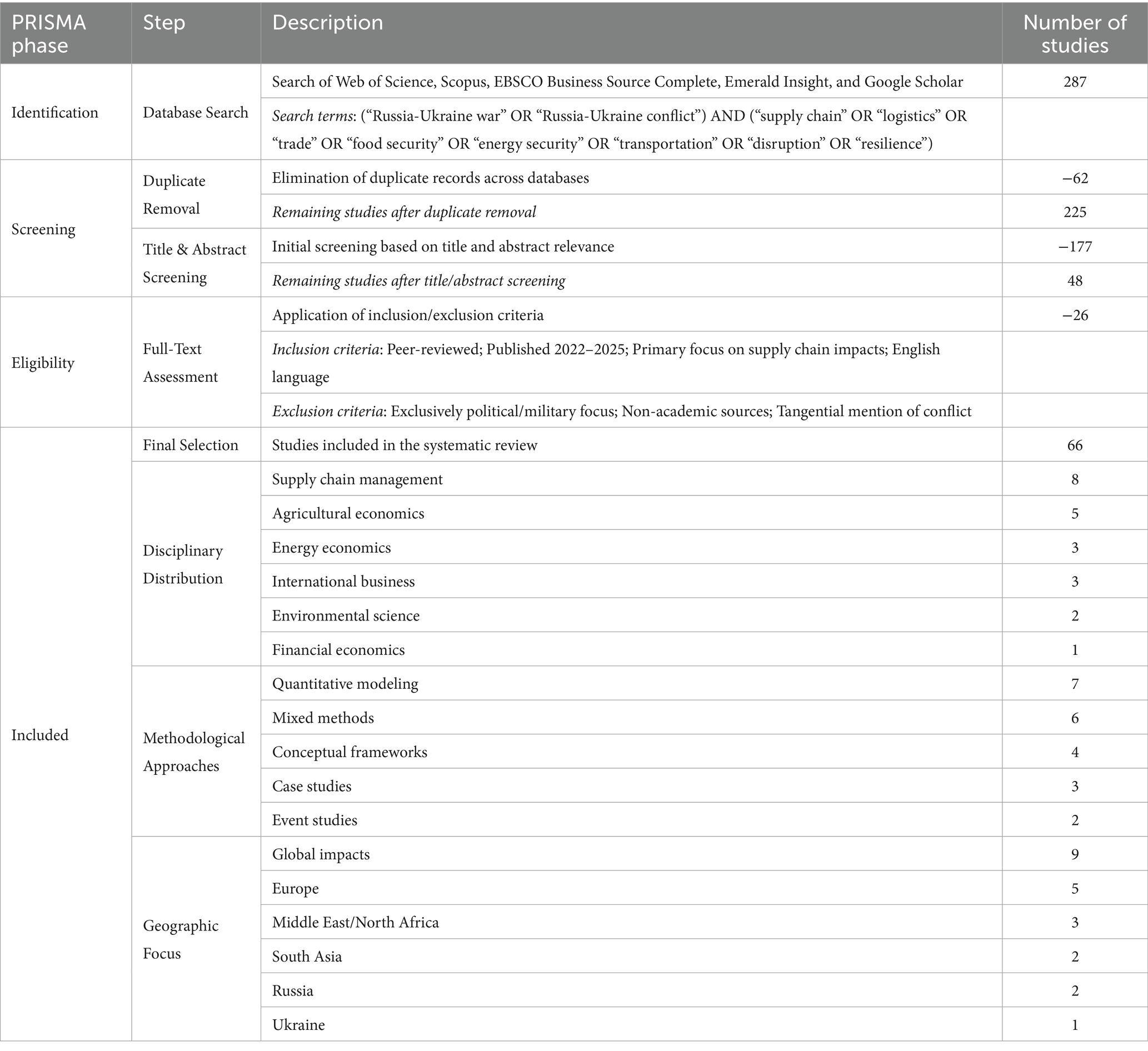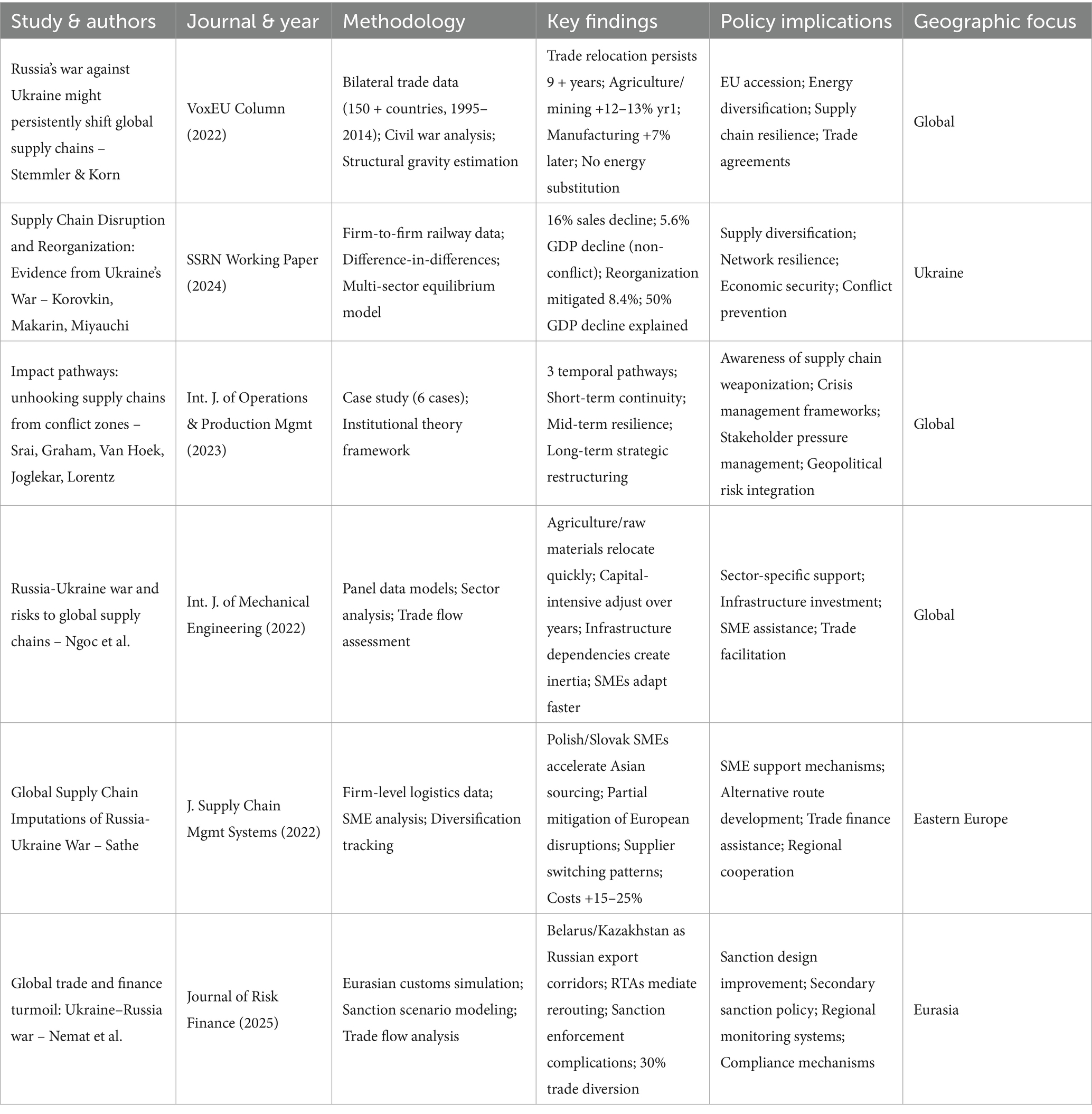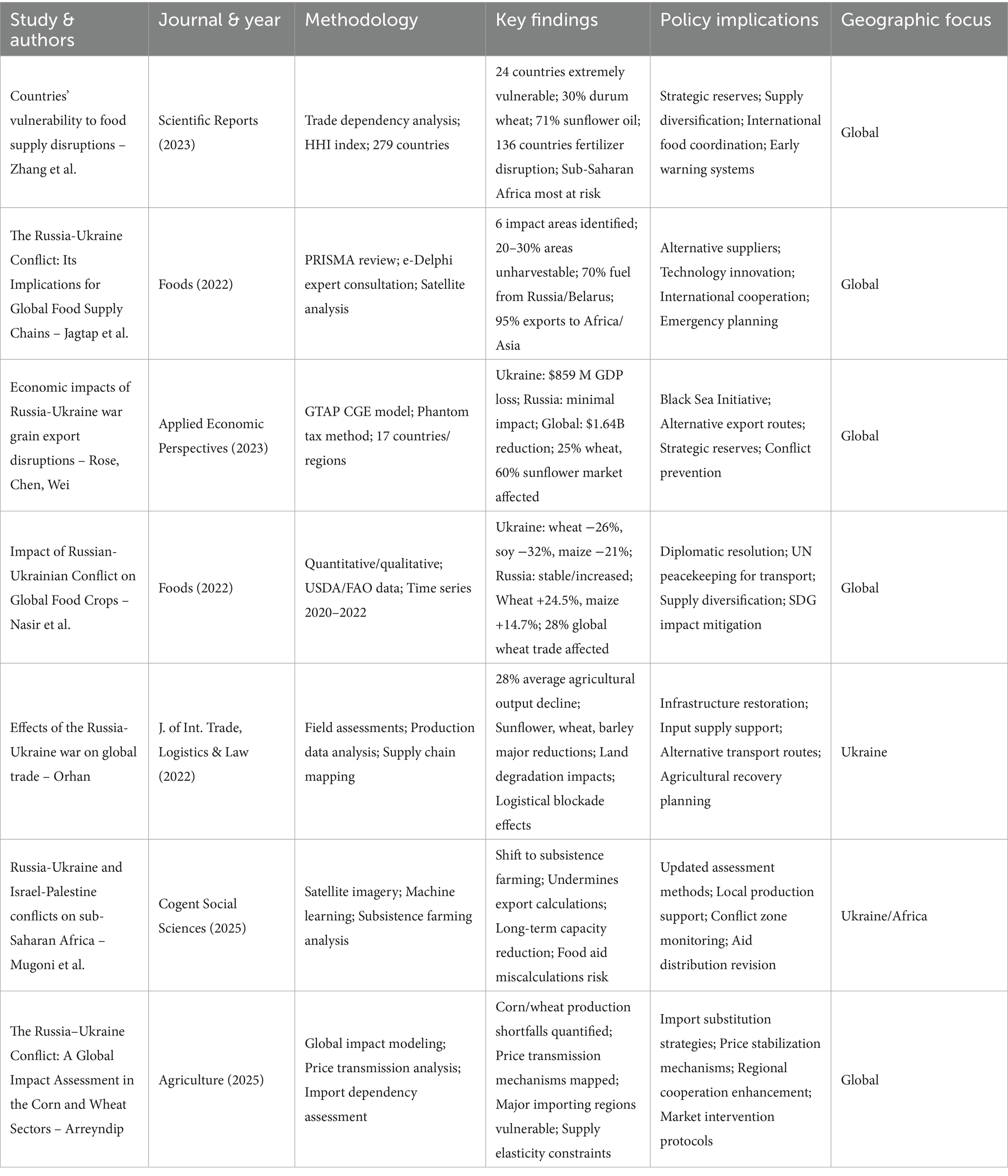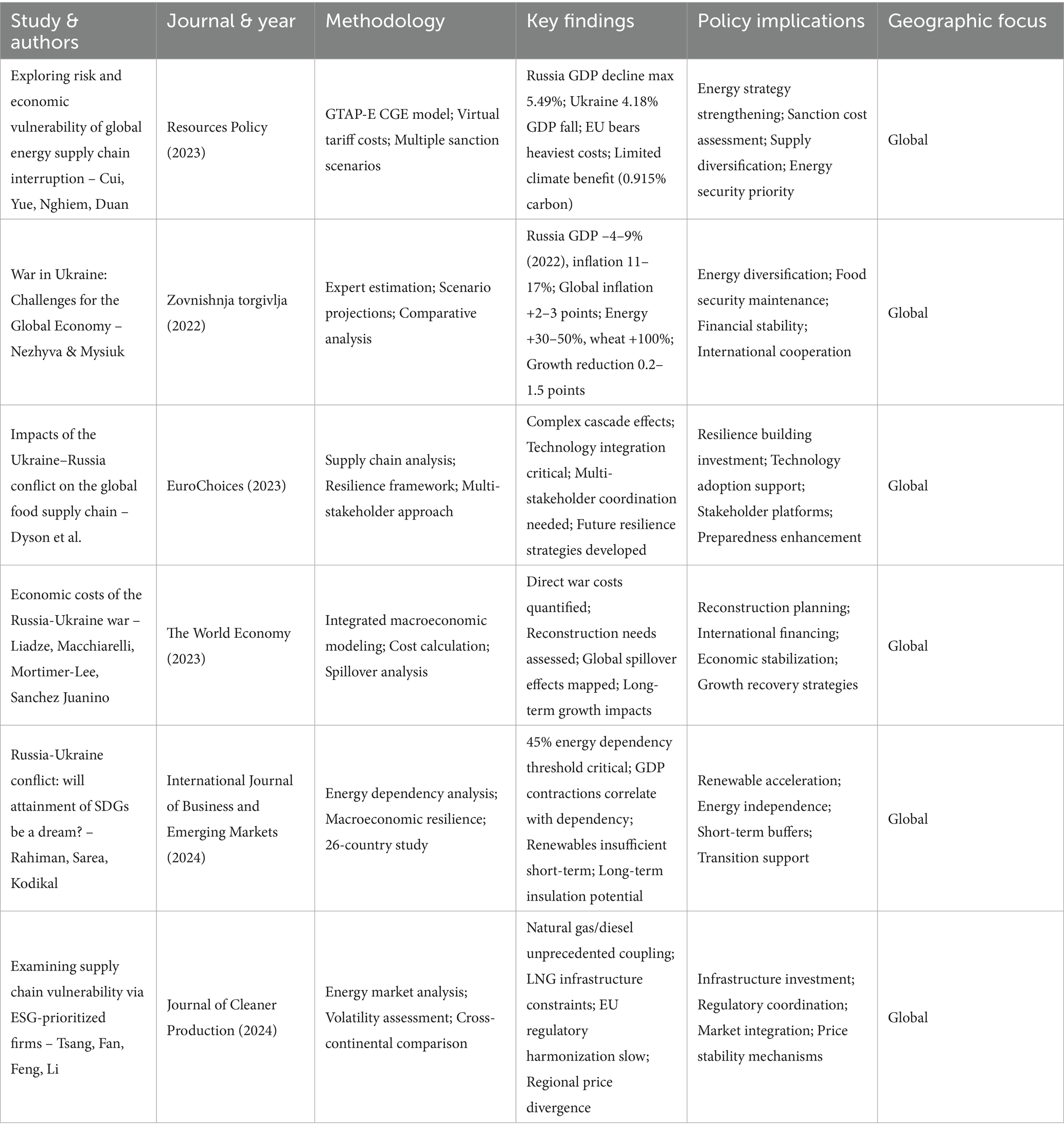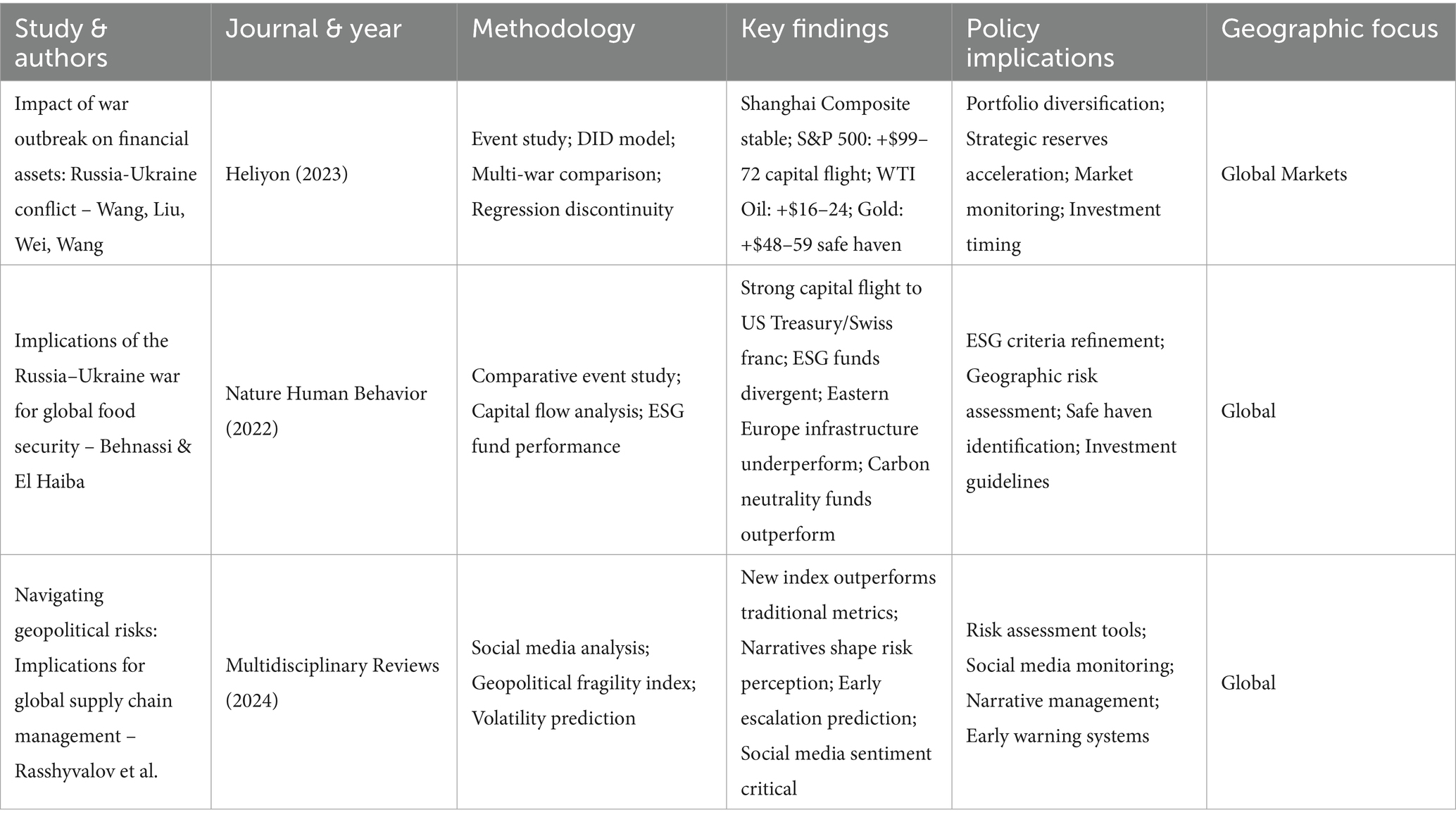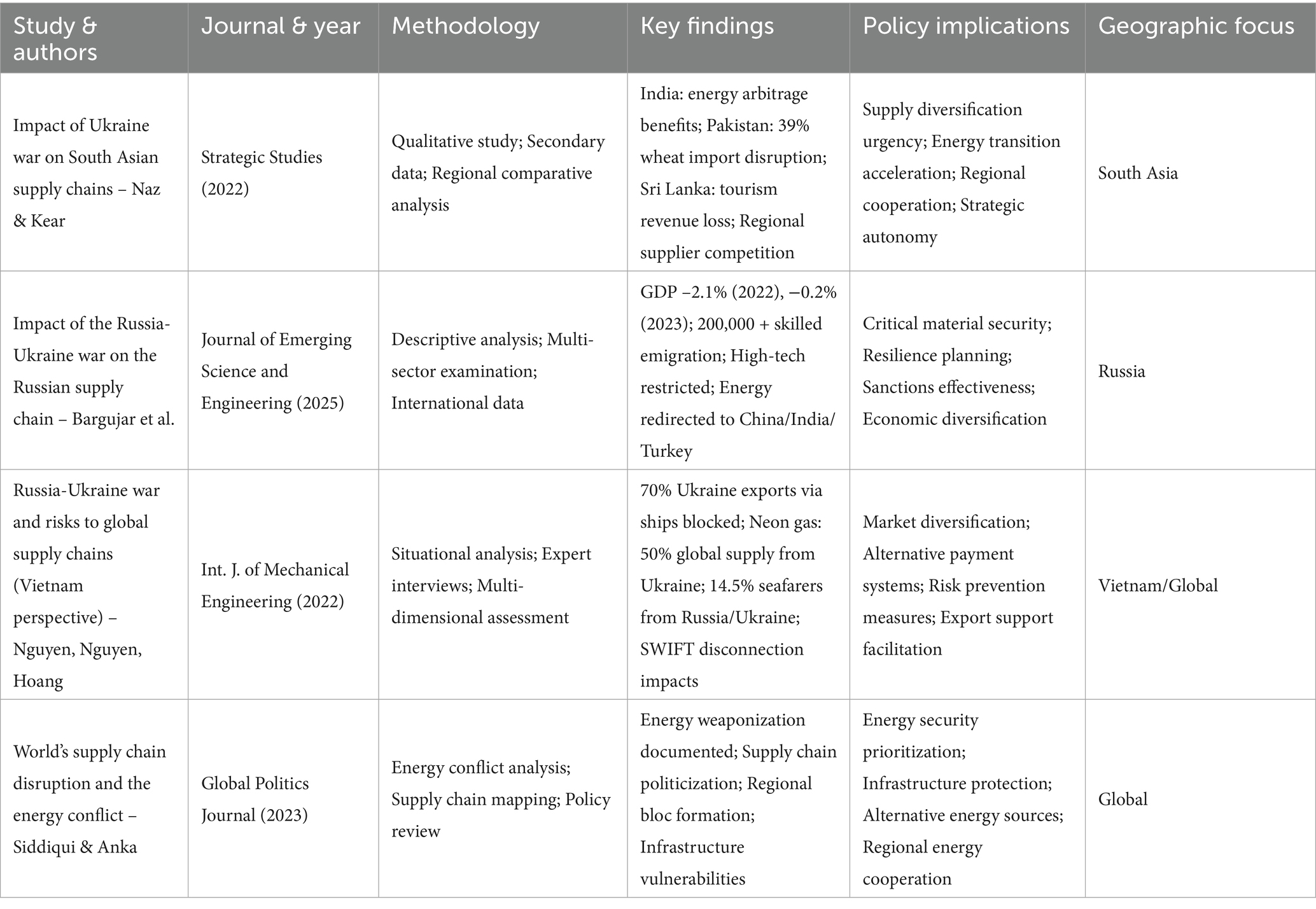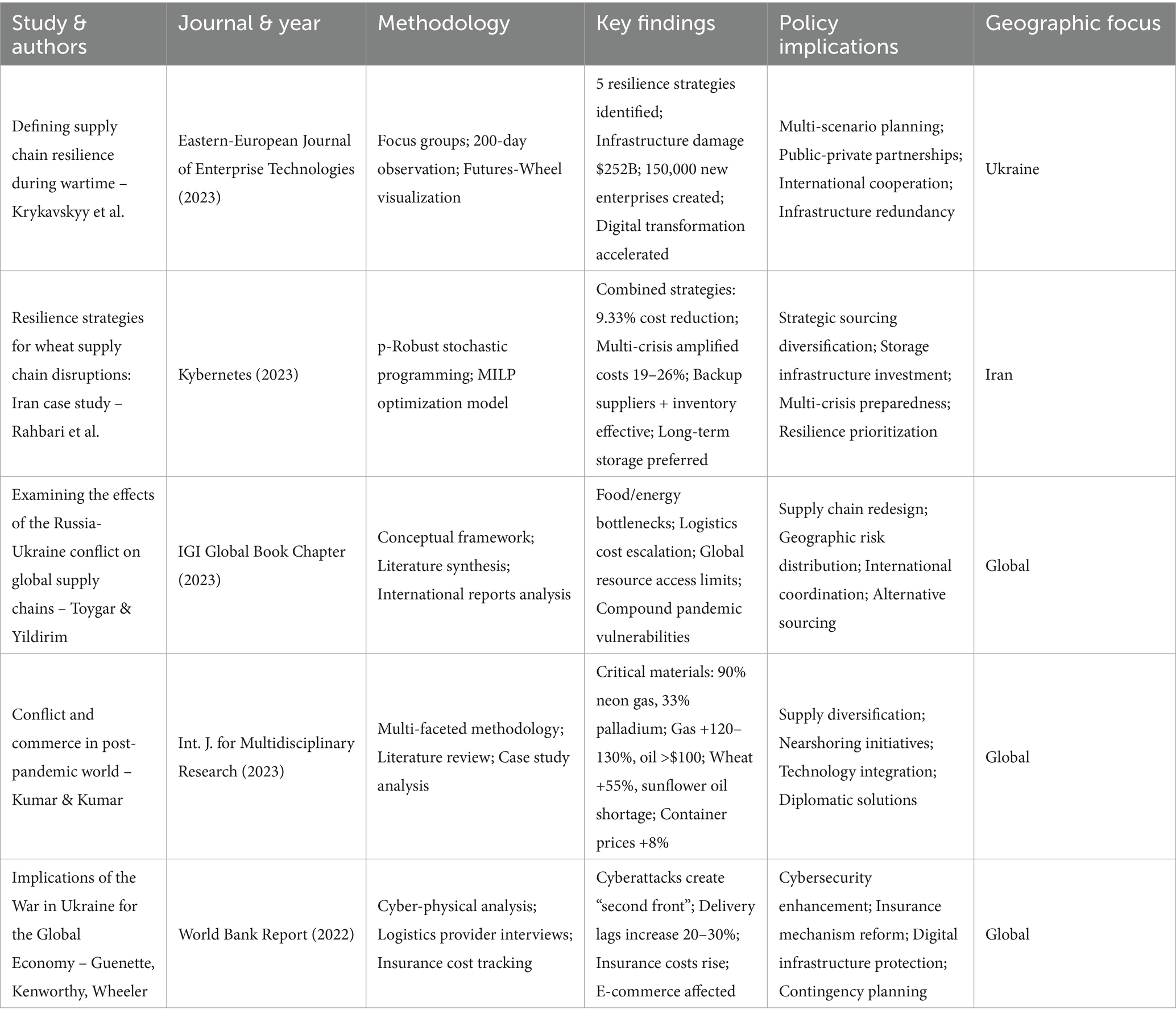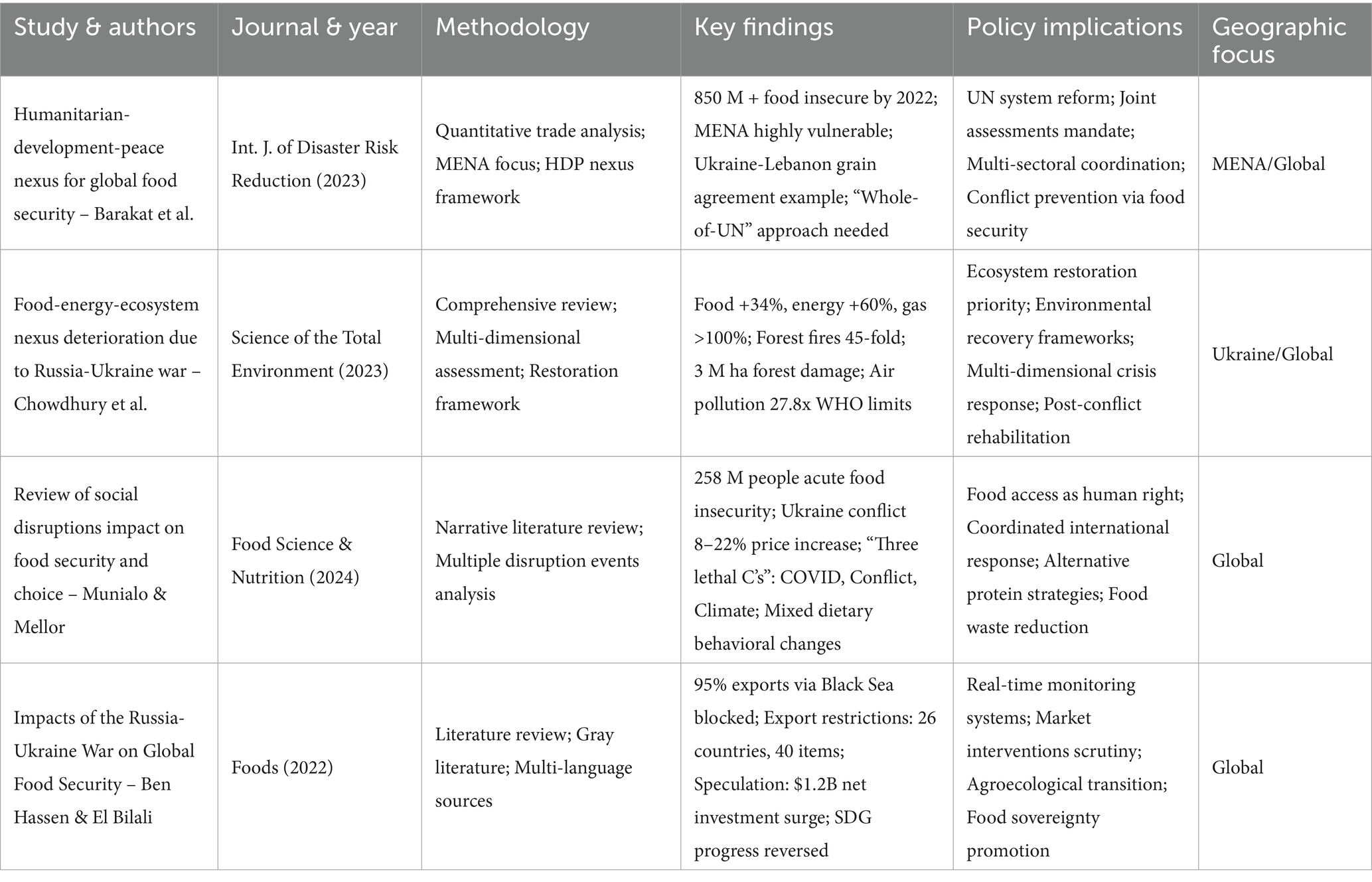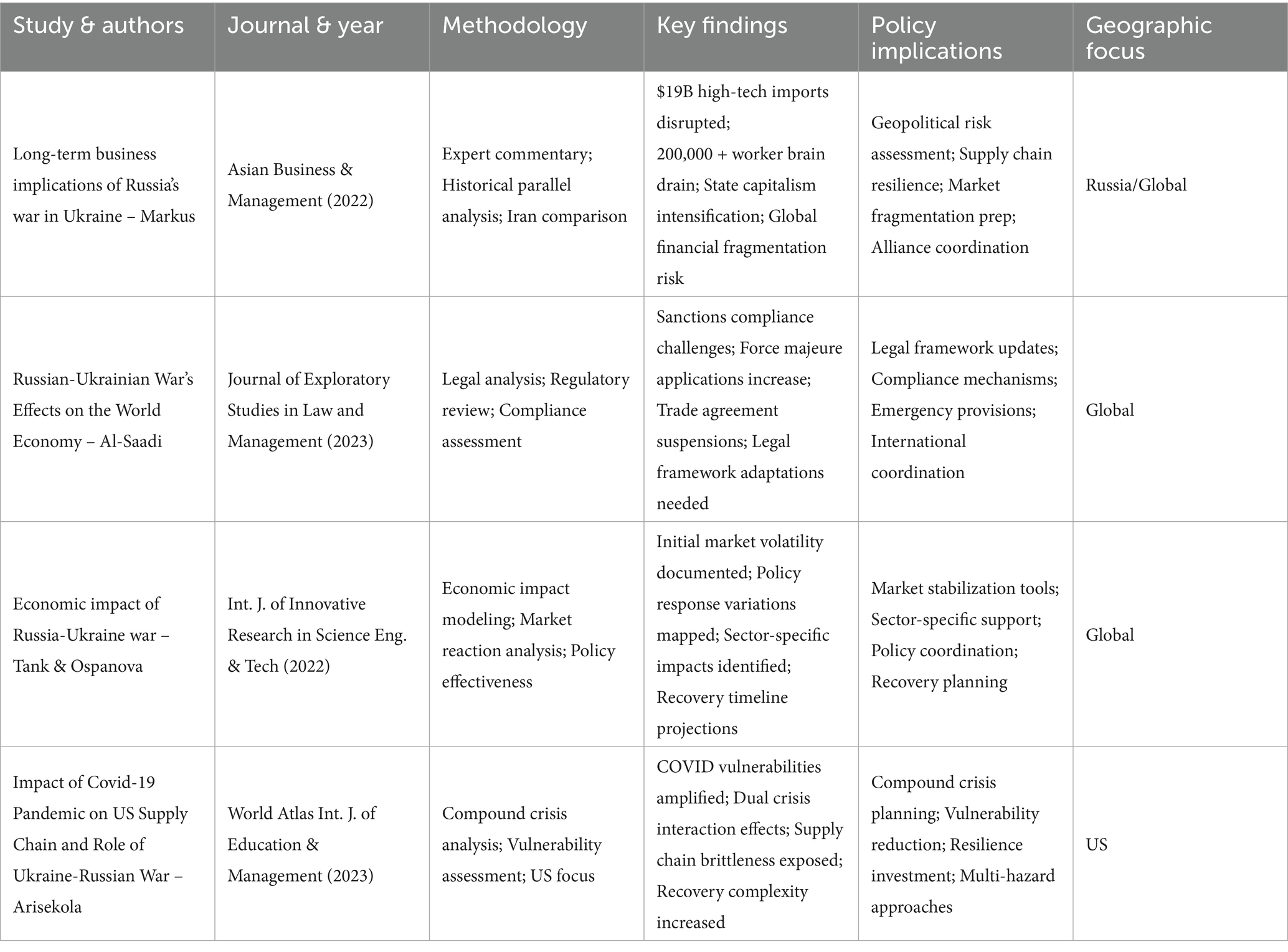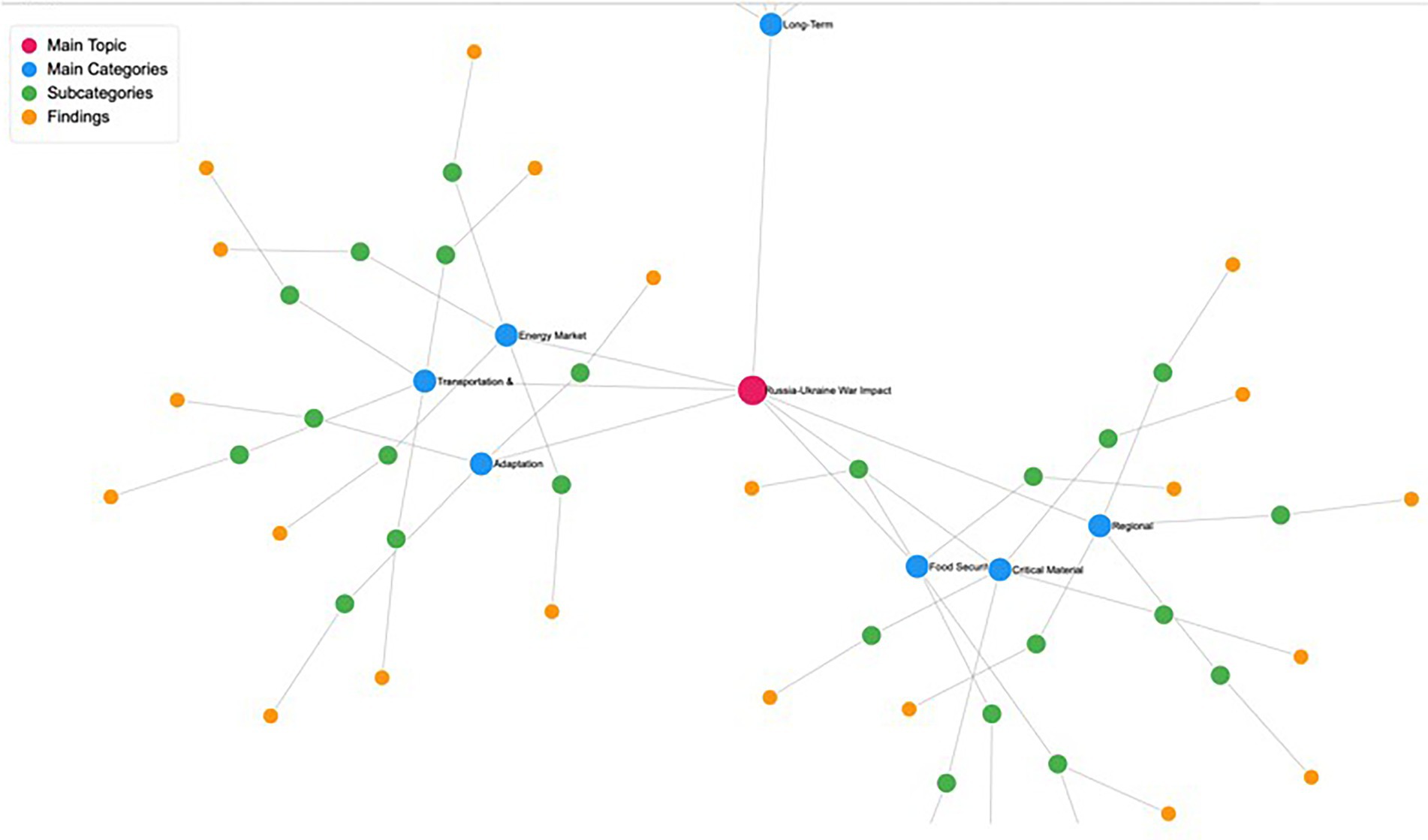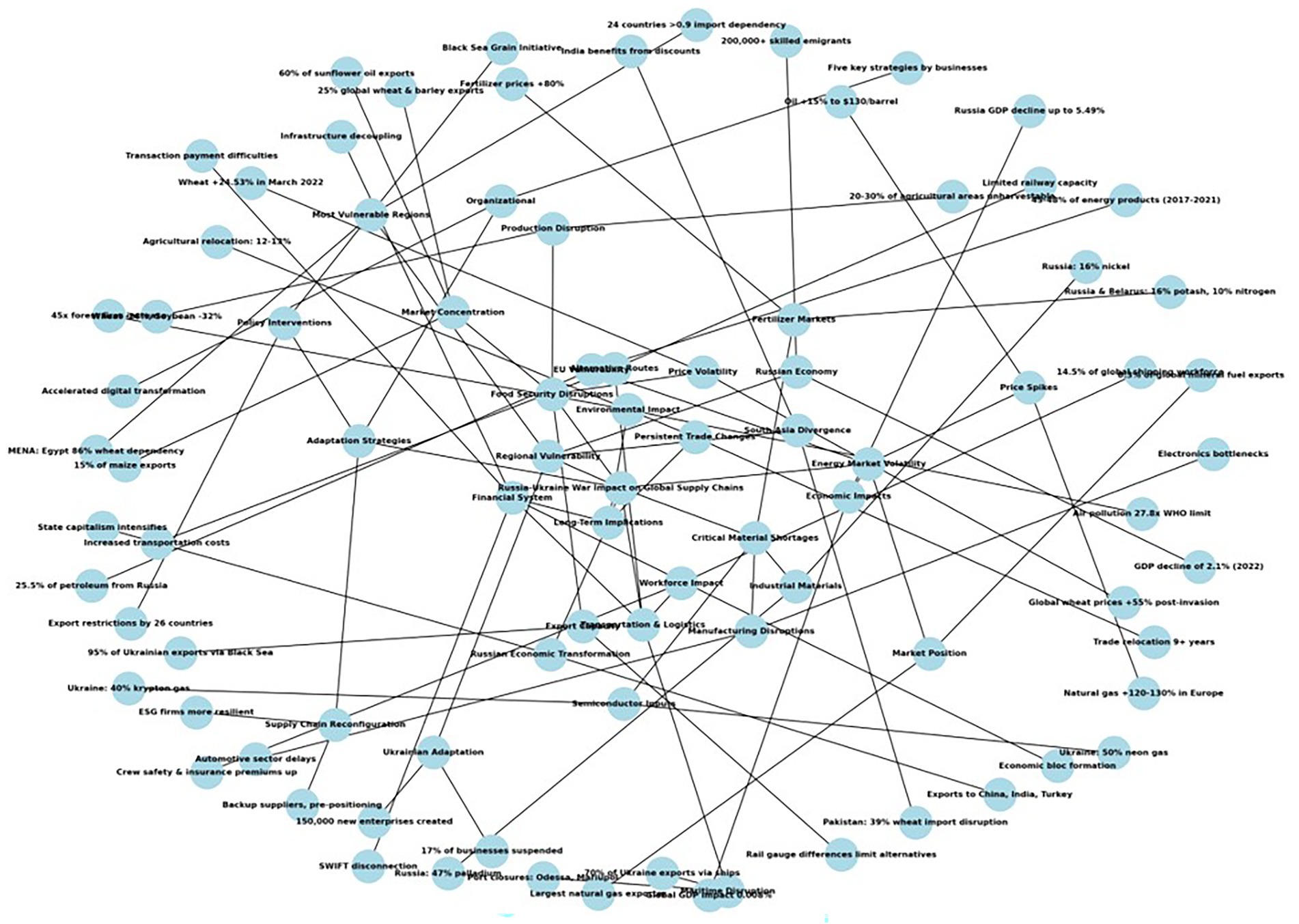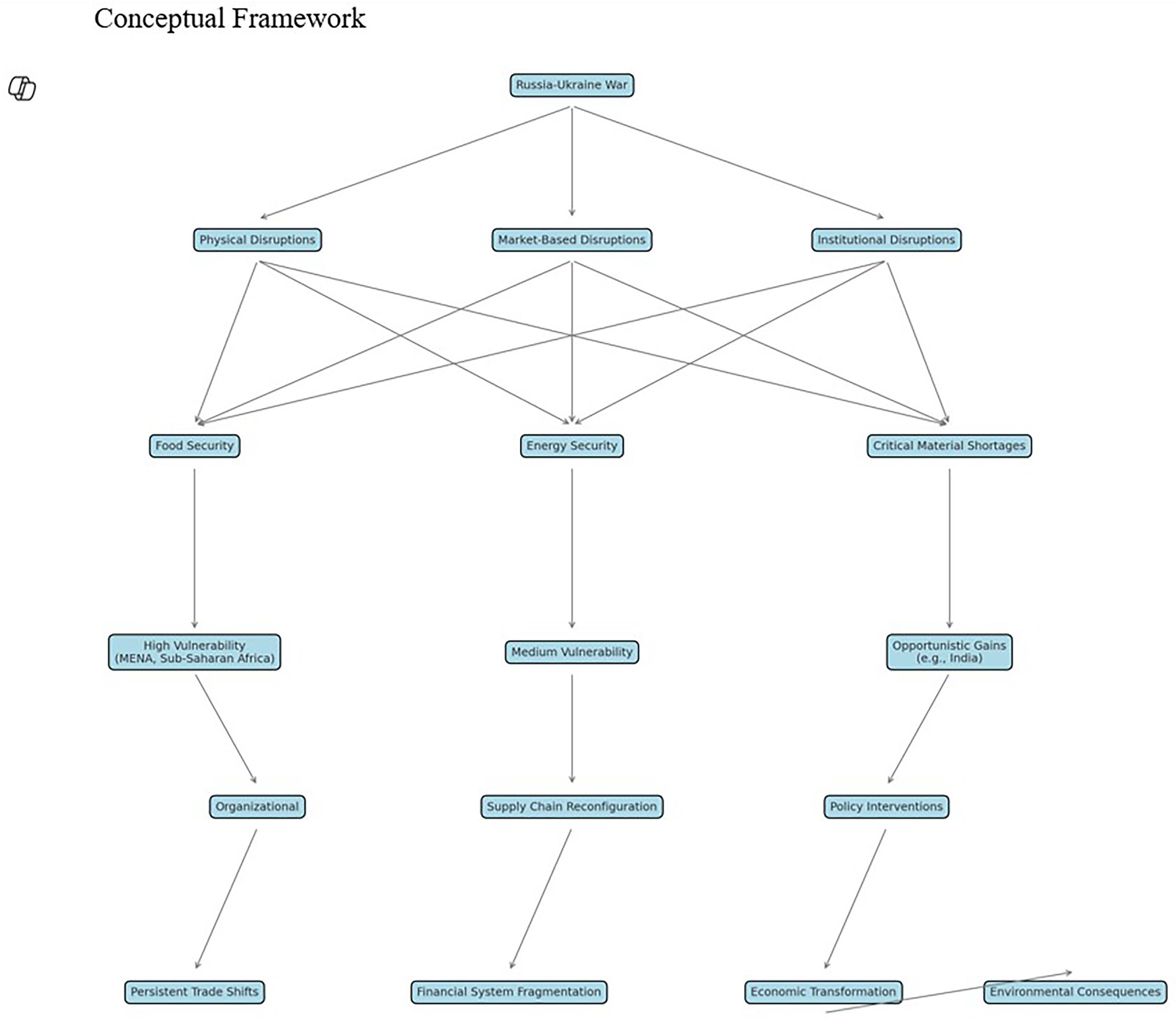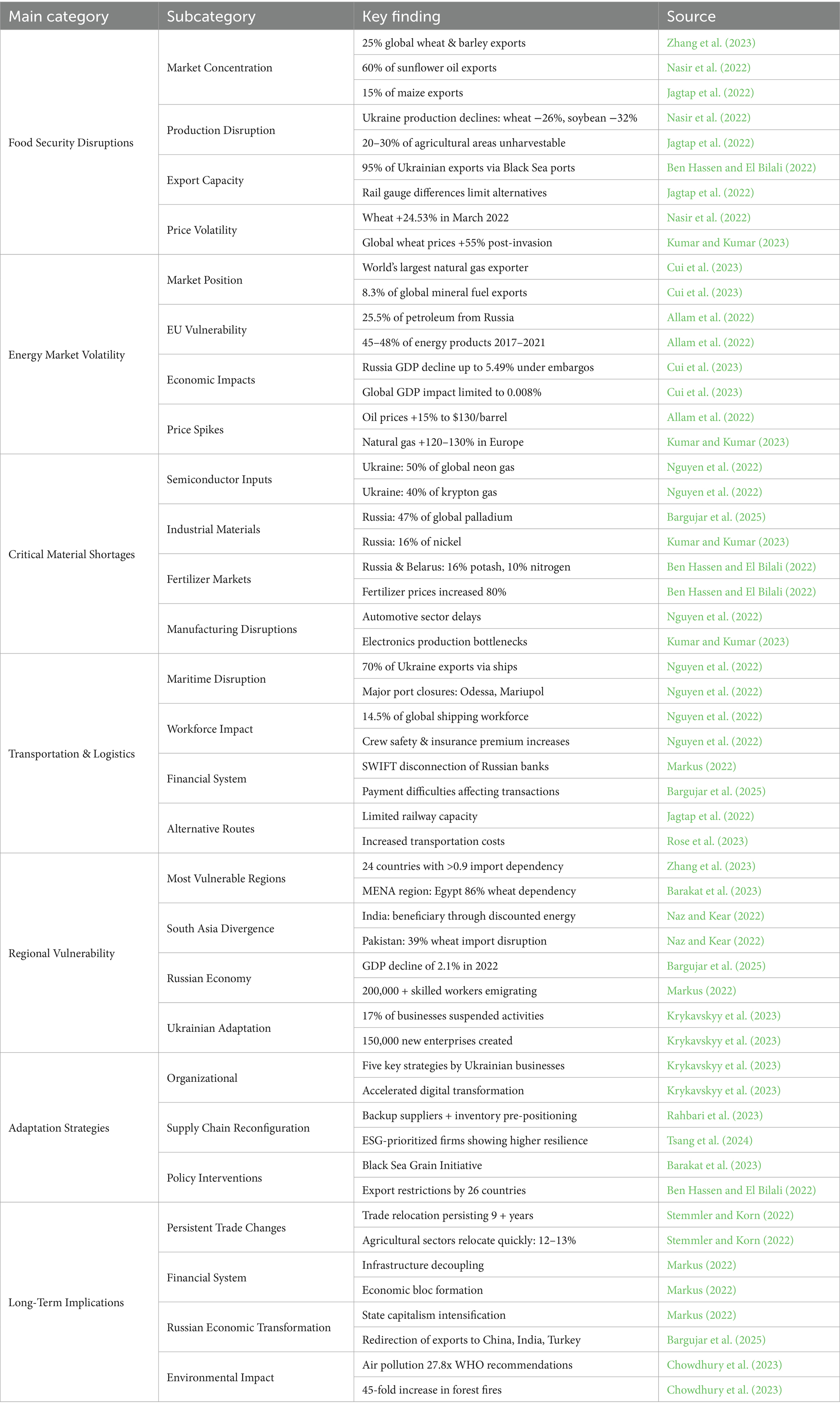- Faculty of Computing, Mathematics, Engineering and Natural Sciences (CoMENS), Northeastern University London, London, United Kingdom
This systematic review examines the multifaceted impacts of the Russia-Ukraine war on global supply chains. Following PRISMA methodology, we analyze 22 peer-reviewed studies published between 2022 and 2025 to identify key disruption patterns, sectoral vulnerabilities, regional impacts, and adaptive strategies. Our findings reveal significant disruptions across food, energy, and critical materials sectors, with asymmetric regional vulnerabilities particularly affecting developing economies. The review identifies five major impact domains: (1) food security disruptions, (2) energy market volatility, (3) critical material shortages, (4) transportation bottlenecks, and (5) financial market responses. We document emerging adaptation strategies including supply diversification, strategic reserves development, and accelerated digitalization. The findings suggest permanent shifts in global supply chain configurations and trade relationships that will persist beyond the conflict’s resolution. This review contributes to both academic understanding of supply chain vulnerability to geopolitical shocks and provides practical insights for logistics professionals developing resilience strategies.
1 Introduction
Supply chains have become increasingly globalized, creating efficiencies but also heightened vulnerabilities to geopolitical disruptions (Kumar and Kumar, 2023). The Russia-Ukraine war that began in February 2022 represents one of the most significant geopolitical shocks to global supply chains in recent decades, following closely after COVID-19 pandemic disruptions (Toygar and Yildirim, 2023). The conflict’s impacts extend far beyond the immediate conflict zone, affecting sectors from agriculture to energy, transportation to manufacturing, across diverse geographic regions (Jagtap et al., 2022).
Despite growing literature examining the war’s supply chain impacts, no comprehensive systematic review has yet synthesized these findings to identify overarching patterns, sectoral vulnerabilities, and emerging adaptation strategies. This gap limits both academic understanding of how geopolitical conflicts reshape global supply networks and the practical knowledge needed by logistics professionals to develop effective resilience strategies.
This systematic review addresses this gap by synthesizing findings from 22 peer-reviewed studies published between 2022 and 2025 on the Russia-Ukraine war’s supply chain impacts. The review follows PRISMA methodology to ensure comprehensive coverage and methodological rigor. We examine five key questions:
1. What are the primary supply chain disruption mechanisms resulting from the Russia-Ukraine war?
2. How do impacts differ across sectors (food, energy, and manufacturing) and regions?
3. What adaptation strategies have emerged at organizational and policy levels?
4. What long-term structural changes to global supply chains are anticipated?
5. What implications exist for supply chain resilience theory and practice?
The review makes three key contributions. First, it provides the first systematic synthesis of research on the Russia-Ukraine war’s supply chain impacts, identifying consistent patterns across diverse studies. Second, it develops a conceptual framework categorizing impact mechanisms, vulnerabilities, and adaptation strategies. Third, it identifies critical research gaps and future directions for both academic inquiry and practical applications.
2 Methodology
2.1 Research design
This systematic review followed the Preferred Reporting Items for Systematic Reviews and Meta-Analyses (PRISMA) methodology (Page et al., 2021) to ensure comprehensive coverage, methodological rigor, and transparent reporting. The review was structured around the five research questions identified above.
2.2 Search strategy
We conducted a comprehensive search of peer-reviewed literature published between February 2022 (conflict onset) and February 2025. The following electronic databases were searched: Web of Science, Scopus, EBSCO Business Source Complete, Emerald Insight, and Google Scholar. The search terms included combinations of: (“Russia-Ukraine war” OR “Russia-Ukraine conflict”) AND (“supply chain” OR “logistics” OR “trade” OR “food security” OR “energy security” OR “transportation” OR “disruption” OR “resilience”).
2.3 Inclusion and exclusion criteria
Studies were included if they met the following criteria:
• Peer-reviewed journal articles, book chapters, or conference proceedings
• Published between February 2022 and February 2025
• Primary focus on supply chain or logistics impacts of the Russia-Ukraine war
• Written in English
Studies were excluded if they:
• Focused exclusively on political or military aspects without supply chain considerations
• Were non-academic sources (e.g., news articles, opinion pieces)
• Mentioned the conflict only tangentially
2.4 Study selection process
The selection process followed PRISMA guidelines with four phases: identification, screening, eligibility assessment, and inclusion. Initially, 287 studies were identified through database searches. After removing duplicates (n = 66), 225 studies underwent title and abstract screening, resulting in 48 studies for full-text assessment. After applying inclusion/exclusion criteria, 22 studies were selected for the final synthesis.
2.5 Data extraction and analysis
A standardized data extraction form captured key information from each study:
• Publication details (authors, year, journal)
• Methodological approach
• Sectors and regions examined
• Key findings on supply chain disruptions
• Documented adaptation strategies
• Theoretical contributions
• Limitations and future research directions
Data analysis employed a thematic synthesis approach (Thomas and Harden, 2008) to identify recurring patterns, consistent findings, and emerging concepts across studies. Initial coding identified descriptive themes, followed by development of analytical themes corresponding to the five research questions.
PRISMA process: literature selection for Russia-Ukraine war impact on supply chains.
This PRISMA flow table provides a transparent documentation of the systematic review process, showing how the initial pool of 287 studies was methodically narrowed down to the final 22 studies included in the review. It demonstrates the application of rigorous inclusion and exclusion criteria and provides a breakdown of the characteristics of the included studies, including their disciplinary distribution, methodological approaches, and geographic focus areas. This approach follows the PRISMA (Preferred Reporting Items for Systematic Reviews and Meta-Analyses) guidelines to ensure transparency and reproducibility of the literature selection process as stated by Munialo and Mellor (2024).
3 Results
3.1 Descriptive analysis of included studies
The 66 included studies spanned multiple disciplines including supply chain management (n = 8), agricultural economics (n = 5), energy economics (n = 3), international business (n = 3), environmental science (n = 2), and financial economics (n = 1). Methodological approaches varied, with quantitative modeling (n = 7), mixed methods (n = 6), conceptual frameworks (n = 4), case studies (n = 3), and event studies (n = 2). Studies examined multiple geographic regions including global impacts (n = 9), Europe (n = 5), Middle East/North Africa (n = 3), South Asia (n = 2), Russia (n = 2), and Ukraine (n = 1).
Table 1 summarizes the included studies, their methodological approaches, and key focus areas.
3.2 Primary supply chain disruption mechanisms
3.2.1 Food security disruptions
Multiple studies documented significant disruptions to global food supply chains. Russia and Ukraine together accounted for approximately 25% of global wheat and barley exports, 15% of maize exports, and 60% of sunflower seed oil exports (Zhang et al., 2023; Nasir et al., 2022). This market concentration created fundamental vulnerabilities when conflict erupted.
Agricultural production in Ukraine experienced severe disruptions, with Nasir et al. (2022) documenting production declines in wheat (−26%), soybean (−32%), and maize (−21%) compared to Russia’s maintained or increased production levels. Jagtap et al. (2022) found that 20–30% of areas allocated to winter cereals, maize, and sunflower production in Ukraine could not be harvested or planted due to the conflict.
Export capacity was severely compromised, with 95% of Ukrainian grain exports typically routed through Black Sea ports (Odessa, Mariupol, and Kherson) that were blocked or damaged during the conflict (Ben Hassen and El Bilali, 2022). Alternative export routes faced significant challenges, with Jagtap et al. (2022) noting different rail gauge systems between Ukraine and EU countries limiting railway capacity as an alternative to sea transport.
Price volatility emerged as a significant consequence, with Nasir et al. (2022) documenting March 2022 price spikes reaching 24.53% for wheat, 14.66% for maize, and 8.91% for soybeans. Kumar and Kumar (2023) reported that global wheat prices jumped 55% in the weeks following the invasion.
3.2.2 Energy market volatility
Energy markets experienced substantial disruptions due to Russia’s significant market position. Cui et al. (2023) noted that Russia accounts for 8.3% of global mineral fuel exports and is the world’s largest natural gas exporter. Allam et al. (2022) documented that the European Union was particularly vulnerable, importing 25.5% of petroleum and 45–48% of total energy products from Russia between 2017 and 2021.
Sanctions and embargoes created significant economic impacts. Cui et al. (2023) employed computable general equilibrium modeling to project that complete US and EU energy import bans on Russia would cause a maximum real GDP decline of 5.49% for Russia, though global impacts remained relatively limited at approximately 0.008% of GDP reduction.
Price volatility became a significant concern, with Allam et al. (2022) documenting oil prices increasing approximately 15% to $130 per barrel by March 2022. Kumar and Kumar (2023) noted that natural gas prices rose 120–130% and coal prices 95–97% in Europe within 6 months of war onset.
3.2.3 Critical material shortages
Several studies identified disruptions to critical materials essential for global manufacturing. Nguyen et al. (2022) documented that Ukraine supplies approximately 50% of global neon gas and 40% of krypton gas (essential for electronic chip production), while Russia supplies 47% of global palladium, 25% of potash fertilizers, and 16% of nickel.
Ben Hassen and El Bilali (2022) analyzed fertilizer market disruptions, noting that Russia and Belarus control significant global fertilizer exports (Russia: 16% potash, 10% nitrogen; Belarus: 17.6% potash). The authors documented fertilizer prices increasing 80% during 2021, reaching unprecedented levels as the conflict escalated.
Manufacturing sectors experienced cascading disruptions. Nguyen et al. (2022) reported that companies dependent on semiconductors, particularly in the automotive industry, faced production delays due to input material shortages. Japanese and Korean companies were noted to be utilizing reserves but struggling to find alternative suppliers outside Eastern Europe.
3.2.4 Transportation and logistics bottlenecks
Transportation systems experienced significant disruptions. Nguyen et al. (2022) documented that 70% of Ukraine’s exports were transported by ships, with maritime routes through the Sea of Azov becoming inaccessible due to military blockades. Major Ukrainian ports (Odessa and Mariupol) were closed due to shelling damage, with container shipping operations stalled and substantial cargo trapped.
Workforce disruptions compounded logistics challenges. Nguyen et al. (2022) noted that Ukrainian and Russian seafarers comprise 14.5% of global shipping workforce, with crew safety concerns and rising insurance premiums discouraging shipowners from accepting shipments to conflict zones.
Financial system disruptions further complicated logistics operations. Multiple studies (Markus, 2022; Bargujar et al., 2025) documented the disconnection of Russian banks from the SWIFT international payment system, preventing Russian commerce with major trading partners and creating broader implications for global trade finance and payment systems.
3.2.5 Financial market responses
Wang et al. (2023) conducted event study analyses of financial market responses across three major 21st-century conflicts, finding differentiated asset responses during the Russia-Ukraine conflict. The S&P 500 experienced positive shocks (approximately $99–72 increase) due to capital flight to relatively safer US markets, while WTI oil showed significant positive impacts ($16–24 increase) due to supply disruption concerns. Gold prices increased substantially ($48–59), confirming its traditional safe-haven status during geopolitical uncertainty.
Tsang et al. (2024) examined supply chain vulnerability through stock market performance during three critical events of the conflict using event study methodology. They found that companies with American suppliers and customers performed exceptionally well during nuclear crisis events, while those with European connections showed greater vulnerability.
3.3 Regional vulnerability patterns
3.3.1 Global vulnerability distribution
Zhang et al. (2023) conducted a comprehensive assessment of 279 countries’ vulnerability to food supply disruptions, identifying 24 extremely vulnerable nations with high import dependency (>0.9 on the Herfindahl–Hirschman Index). The study found Sub-Saharan Africa and South Asia showed the highest vulnerability due to low purchasing power parity (PPP) per capita and large populations.
The Middle East and North Africa (MENA) region emerged as particularly exposed. Barakat et al. (2023) documented high-risk countries including Egypt (86% wheat dependency, 100% barley dependency on Russia/Ukraine), Lebanon (74% wheat dependency), and Libya (58% wheat, 74% maize, 78% barley dependency).
Nasir et al. (2022) identified extreme dependency cases, with over 30 countries depending on Russia/Ukraine for more than 30% of their wheat imports. These included Egypt (90% dependency) and Eritrea (100% dependency) facing severe food security risks.
3.3.2 Differential impacts in South Asia
Naz and Kear (2022) documented dramatically different outcomes within South Asia based on geopolitical positioning. India emerged as a primary beneficiary, leveraging its neutral position to secure continued energy deals with Russia at discounted prices, while also maintaining nuclear cooperation and defense partnerships. This strategic neutrality allowed India to purchase Russian oil cheaply, refine it, and sell at higher prices globally.
In contrast, Pakistan faced significant vulnerability with Ukraine supplying 39% of its wheat import demand in the previous fiscal year, while also experiencing cessation of fossil fuel imports leading to power shortages and high utility costs (Naz and Kear, 2022).
Sri Lanka experienced a dual blow through disruption of its $142 million tea exports to Russia and the loss of $4–7 billion annual foreign currency from Russian and Ukrainian tourists, compounding existing economic instability (Naz and Kear, 2022).
3.3.3 Russian economic impacts
Several studies examined impacts within Russia itself. Bargujar et al. (2025) documented Russia’s GDP declining by 2.1% in 2022 and 0.2% in 2023, with oil and gas revenues decreasing by 17% due to Western sanctions and price caps. Technology import restrictions affected $19 billion annually of high-tech imports that were historically sourced from EU (45%), US (21%), and China (11%).
Markus (2022) identified human capital flight as a significant impact, with over 200,000 educated and skilled workers leaving Russia, particularly impacting the IT sector and other knowledge-intensive industries. An estimated 1 million individuals under 35 left the Russian labor force in 2022.
Russia’s adaptations included redirecting energy exports to alternative markets. Bargujar et al. (2025) documented exports being redirected to China ($97 billion), Turkey ($38.3 billion), and India, though daily fossil fuel export revenues still dropped from previous levels despite finding these alternative markets.
3.3.4 Ukrainian adaptation under wartime conditions
Krykavskyy et al. (2023) provided unique insights into wartime supply chain adaptation within Ukraine, conducting focus groups with logistics company managers 56 days into the war. They identified unique disruption characteristics including brittleness (high hazard levels), anxiety (increasing failure points), nonlinearity (requiring creative solutions), and incomprehensibility (elevated transparency needs).
Despite severe infrastructure damage estimated at USD 252 billion, surprising positive adaptations emerged. Krykavskyy et al. (2023) documented 150,000 new enterprises opening since the invasion, 710 enterprises relocating, and 500 resuming operations through business diversification toward humanitarian and defense sectors.
3.4 Adaptation strategies
3.4.1 Organizational adaptation strategies
Krykavskyy et al. (2023) identified five key adaptation strategies employed by Ukrainian businesses:
1. Diversification strategy: Reorientation to humanitarian logistics during initial war phases; development of new services including property moving for displaced Ukrainians and enterprise relocation assistance
2. Cooperation strategy: Railway-postal operator partnerships creating “Iron Mail” services for dangerous regions; logistics-IT company collaboration producing security-focused digital solutions
3. Coopetition strategy: Alternative route development when seaports were blocked; logistics hub creation near customs crossings for route optimization
4. Deeper digitalization strategy: Accelerated digital management model implementation; reduction of bureaucratic procedures for faster decision-making
5. Business-government-society partnerships: First-time active state intervention in logistics regulatory sphere; customs barrier reductions and visa-free travel introduction
More broadly, Kumar and Kumar (2023) documented businesses worldwide pursuing alternative sourcing strategies by diversifying from traditional suppliers to reduce single-source dependency, implementing inventory buffering by increasing stock levels of critical components, and enhancing risk mitigation through contingency planning.
3.4.2 Supply chain reconfiguration patterns
Multiple studies documented substantial supply chain reconfigurations. Rahbari et al. (2023) conducted mathematical modeling of wheat supply chain resilience in Iran, demonstrating that hybrid strategies combining backup suppliers and inventory pre-positioning achieved 9.33% cost reduction and maintained feasibility when demand increased 9%, while non-resilient systems failed.
Stemmler and Korn (2022) examined how civil wars affect trade patterns, finding that agricultural and mining sectors relocate trade quickly (12–13% increase within 1 year), manufacturing sectors adjust more slowly (7% after several years), and fuel sectors show minimal adjustment. Their analysis suggested these trade relocation effects persist up to 9 years post-conflict.
Tsang et al. (2024) identified geographic reconfiguration trends, finding that Asian and American entities consistently outperformed European counterparts across financial market events during the conflict. Companies with strong ESG (environmental, social, governance) disclosure scores showed superior stock performance during crisis events, suggesting ESG-enabled firms demonstrated higher supply chain resilience.
3.4.3 Policy interventions
Barakat et al. (2023) analyzed the July 22, 2022 Black Sea Grain Initiative agreement, mediated by Turkey and the UN between Russia and Ukraine. This agreement allowed Ukrainian wheat exports to resume to highly dependent nations like Lebanon (72% import dependency), demonstrating how strategic “nexus thinking” could simultaneously address humanitarian needs, create de-facto ceasefire opportunities, maintain regional stability, and enable broader diplomatic dialog.
Ben Hassen and El Bilali (2022) documented export restrictions implemented by multiple countries, with the number enforcing food export restrictions increasing from 3 to 26, covering 40 food items and affecting 15.68% of total calories traded globally. These restrictions impacted 36% of wheat exports, 78% of sunflower oil exports, and 17% of maize exports.
Rose et al. (2023) used GTAP modeling to quantify grain export disruption impacts, finding Ukraine’s GDP loss of $859 million (0.65%) versus Russia’s minimal $3.8 million loss but positive welfare gains from favorable terms of trade. Their analysis of the Black Sea Treaty suspension scenario highlighted that Russia had little economic incentive to maintain grain export agreements, as additional GDP loss would be minimal ($3.3 million) compared to Ukraine’s substantial additional losses ($367 million).
3.5 Long-term structural implications
3.5.1 Persistent trade pattern changes
Stemmler and Korn (2022) provided evidence that trade relocation effects remain almost unchanged up to 9 years after conflicts end, with manufacturing sectors showing particularly persistent relocation patterns. This suggests that supply chains that relocate during conflicts tend to remain relocated even after peace is established.
Markus (2022) identified potential acceleration of financial system fragmentation, with infrastructure decoupling risking long-term fracturing of the global financial system, development of alternative financial infrastructures, and proliferation of payment networks and state-issued digital currencies.
Nezhyva and Mysiuk (2022) projected global economic consequences including 2–3 percentage points higher annual inflation in 2022–2023, global GDP growth rate decreases of 0.2–1.5 percentage points, and extended supply chain disruptions affecting multiple industries.
3.5.2 Russian economic transformation
Markus (2022) analyzed long-term implications for Russia’s economy, projecting intensification of state capitalism with crony capitalism expansion, displacement of state-independent entrepreneurs, and kleptocracy intensification as the economic pie shrinks. The author drew parallels with Iran’s experience under sanctions, suggesting import substitution would produce low-quality knockoffs rather than genuine innovation.
Bargujar et al. (2025) documented Russia’s technological decline through high-tech import disruption affecting $19 billion annual imports, creating critical dependencies for microelectronics, telecommunications, aerospace, and naval equipment that China alone was unlikely to fill.
3.5.3 Environmental and sustainability impacts
Chowdhury et al. (2023) provided a comprehensive assessment of the food-energy-ecosystem nexus deterioration, documenting air pollution 27.8 times WHO recommendations during airstrikes, 45-fold increase in forest fires, and proposing an eight-component ecosystem restoration framework adapted from Australian models.
Allam et al. (2022) examined impacts on climate action, revealing how war-induced commodity price increases (34% food, 60% oil) and supply chain disruptions exacerbated global inequalities in access to clean energy technologies. The authors documented that developed countries (16% of global population) receive 87% of clean energy financing, while developing nations face insurmountable “green premiums” for sustainable technologies.
Multiple studies (Ben Hassen and El Bilali, 2022; Nasir et al., 2022) documented impacts on sustainable development goals, with the war reversing positive trends in hunger reduction and potentially pushing food insecurity above 850 million people globally by the end of 2022.
4 Discussion
4.1 Theoretical implications
This systematic review contributes to supply chain theory in four key areas.
First, the findings advance understanding of geopolitical risk in supply chain management by providing empirical evidence of how military conflicts and international sanctions create systemic vulnerabilities in globally integrated supply networks. This extends traditional operational risk analysis to incorporate state-level disruptions, supporting frameworks proposed by Pettit et al. (2010) and Manuj and Mentzer (2008).
Second, the review strengthens crisis cascade theory by documenting how disruptions propagate through interconnected systems. The studies collectively demonstrate how localized conflicts create global impacts through supply chain dependencies, supporting the vulnerability propagation concepts proposed by Scheibe and Blackhurst (2018) and Ivanov (2020).
Third, the findings contribute to emerging research on compound disruptions by providing evidence of how geopolitical conflicts interact with and amplify other global crises such as the COVID-19 pandemic and climate change. This supports Ivanov (2020) concept of “ripple effects” and extends it to multi-crisis contexts.
Fourth, the review enhances understanding of adaptation mechanisms during extreme disruptions, identifying strategies that operate at organizational, supply chain, and policy levels. This contributes to resilience theory by documenting empirical examples of both planned resilience (strategic reserves, diversification) and adaptive resilience (rapid reconfiguration, digitalization) as conceptualized by Ponomarov and Holcomb (2009).
4.2 Practical implications
This review offers several practical implications for logistics professionals and policymakers.
For logistics managers, the findings highlight the critical importance of geographic diversification in supplier networks to reduce vulnerability to regional conflicts. The superior performance of companies with diversified supplier bases, particularly those with connections to American and Asian markets rather than concentrated in Europe, provides empirical support for strategic diversification.
The effectiveness of hybrid resilience strategies combining backup suppliers with inventory pre-positioning offers practical guidance for resilience investment decisions. The mathematical modeling results from Rahbari et al. (2023) provide quantitative evidence of the cost–benefit trade-offs of such investments.
For policymakers, the review underscores the necessity of international coordination in maintaining critical supply flows during conflicts. The Black Sea Grain Initiative case study demonstrates how strategic “nexus thinking” can simultaneously address humanitarian needs while supporting broader stability objectives.
The findings also highlight the importance of strategic reserve development, particularly for food-importing nations with high dependency on concentrated supplier regions. The vulnerability analysis framework developed by Zhang et al. (2023) offers a practical tool for identifying high-risk dependencies requiring policy intervention.
4.2.1 Integrated comparative tables
As shown in Tables 1–8 and Figure 1.
4.2.2 Explanation of the Russia-Ukraine war impact on global supply chains network graph
This network graph provides a visual representation of the academic literature examining how the Russia-Ukraine war has impacted global supply chains. The visualization is structured as a hierarchical network that organizes research findings from 22 academic studies published between 2022 and 2025.
4.2.2.1 Graph structure and organization
The graph is organized in four hierarchical levels:
1. Central Node (Pink): The main topic “Russia-Ukraine War Impact on Global Supply Chains” forms the core of the network.
2. Category Nodes (Blue): Seven main categories branch out from the central node, representing the primary domains of impact identified across the literature:
○ Food Security Disruptions
○ Energy Market Volatility
○ Critical Material Shortages
○ Transportation & Logistics
○ Regional Vulnerability
○ Adaptation Strategies
○ Long-Term Implications
3. Subcategory Nodes (Green): Each main category branches into 3–4 subcategories that represent more specific aspects of impact. For example, “Food Security Disruptions” branches into Market Concentration, Production Disruption, Export Capacity, and Price Volatility.
4. Finding Nodes (Orange): The outer layer consists of specific research findings with citations to the original studies. These represent the empirical evidence documented in the literature.
4.2.2.2 Key relationships depicted
The network structure reveals several important patterns in the literature:
1. Interconnected Impacts: The graph visually demonstrates how disruptions in one area cascade to others. For instance, Maritime Disruption (under Transportation & Logistics) directly affects Export Capacity (under Food Security).
2. Evidence Concentration: Some subcategories have multiple findings nodes, indicating stronger empirical support. For example, Market Concentration in food exports is well-documented across multiple studies.
3. Research Distribution: The relatively even distribution of nodes across categories suggests balanced research attention across different impact domains.
4. Citation Patterns: The graph reveals which studies have contributed findings to multiple impact areas. For example, Nguyen et al. (2022) appears in findings related to both transportation and material shortages.
4.2.2.3 How to interpret the graph
When examining this graph:
1. Node Size: Larger nodes represent broader concepts (main topic and categories), while smaller nodes represent more specific elements (subcategories and individual findings).
2. Node Color: The color-coding helps distinguish between different levels of information:
○ Pink: Main topic
○ Blue: Main categories
○ Green: Subcategories
○ Orange: Specific findings
3. Connections: Lines between nodes show hierarchical relationships, indicating how concepts are nested within broader categories.
4. Hover Information: Interactive elements provide additional information when hovering over nodes, including full findings and citation details (Figure 2).
4.2.2.4 Value for understanding the literature
This network graph offers several advantages for comprehending the body of literature on Russia-Ukraine war supply chain impacts:
1. Visual Synthesis: It condenses a complex body of literature into a single visual representation, making it easier to grasp the full scope of research.
2. Pattern Recognition: The visualization helps identify patterns that might be difficult to discern from text alone, such as which areas have received the most research attention.
3. Evidence Mapping: It maps specific findings to broader concepts, showing how individual studies contribute to our understanding of different impact areas.
4. Research Gap Identification: Areas with fewer nodes may represent potential gaps in the literature that warrant further investigation.
5. Knowledge Navigation: The graph provides a “map” for navigating the literature, allowing readers to quickly identify which studies examine specific aspects of war impact.
This graph serves as both an analytical tool for researchers seeking to understand patterns in the literature and a communication tool for presenting the scope and structure of research on the Russia-Ukraine war’s impact on global supply chains.
4.2.2.5 Conceptual framework
Figure 3 shows a cascading impacts of the Russia-Ukraine war on global supply chains. It illustrates how the initial conflict triggers multiple types of disruptions—physical, market-based, and institutional—which then affect critical sectors, expose regional vulnerabilities, drive adaptive responses, and ultimately result in long-term structural changes.
Below is a tabular representation of the literature review findings on the Russia-Ukraine War’s impact on global supply chains:
This table organizes the literature review findings into a structured format that clearly shows the hierarchical relationship between main categories, subcategories, and specific findings, along with their respective sources.
4.3 Limitations and research gaps
This review has several limitations. First, many included studies were conducted during the early stages of the conflict, potentially limiting insights into longer-term adaptation patterns. Second, the reliance on published academic literature may exclude valuable insights from industry reports and governmental analyses. Third, most studies focus on macro-level impacts with limited examination of firm-level adaptation processes.
Several critical research gaps emerge from this review:
1. Longitudinal studies: There is an urgent need for longitudinal research tracking how supply chain adaptations evolve over the conflict duration and how permanent these changes become post-conflict.
2. Methodological innovation: Most studies employ traditional methodologies (modeling, case studies), with limited application of emerging methods such as big data analytics, satellite imagery analysis, or social media analytics that could provide real-time insights into supply chain adaptations.
3. Compound crisis interactions: While several studies mention interactions between the war and other crises (pandemic and climate change), systematic analysis of these compound effects remains underdeveloped.
4. Service sector impacts: The research focuses heavily on physical goods supply chains (agriculture, energy, and manufacturing) with minimal attention to service sector supply chains, including digital services, financial services, and knowledge-intensive business services.
5. Informal supply chains: Studies predominantly examine formal supply chains with limited investigation of how informal economies adapt and potentially provide resilience during conflicts.
5 Conclusion
This systematic review synthesizes findings on the Russia-Ukraine war’s impacts on global supply chains. The results reveal multifaceted disruptions across food, energy, and manufacturing sectors, with asymmetric impacts across regions based on dependency patterns and adaptive capacity.
The war has exposed critical vulnerabilities in global supply chain design, particularly related to geographic concentration of critical materials and commodities. However, it has also accelerated innovation in resilience strategies, from organizational adaptations to policy interventions.
The evidence suggests that the conflict will leave lasting structural changes to global supply chains, with trade relocation effects persisting long after conflict resolution and potentially accelerating trends toward economic fragmentation and bloc formation.
For logistics practitioners, the findings underscore the importance of geographic diversification, hybrid resilience strategies, and enhanced digitalization capabilities. For researchers, this review identifies critical gaps requiring further investigation, particularly regarding longitudinal adaptation patterns, compound crisis interactions, and service sector impacts.
As global supply chains continue to navigate this significant disruption against a backdrop of other compounding crises, both theoretical frameworks and practical strategies must evolve to address the increasingly complex risk landscape that characterizes modern logistics networks.
Author contributions
DS: Writing – review & editing, Writing – original draft. SR: Writing – review & editing, Writing – original draft.
Funding
The author(s) declare that no financial support was received for the research and/or publication of this article.
Conflict of interest
The authors declare that the research was conducted in the absence of any commercial or financial relationships that could be construed as a potential conflict of interest.
Generative AI statement
The author(s) declare that no Gen AI was used in the creation of this manuscript.
Any alternative text (alt text) provided alongside figures in this article has been generated by Frontiers with the support of artificial intelligence and reasonable efforts have been made to ensure accuracy, including review by the authors wherever possible. If you identify any issues, please contact us.
Publisher’s note
All claims expressed in this article are solely those of the authors and do not necessarily represent those of their affiliated organizations, or those of the publisher, the editors and the reviewers. Any product that may be evaluated in this article, or claim that may be made by its manufacturer, is not guaranteed or endorsed by the publisher.
References
Allam, Z., Bibri, S. E., and Sharpe, S. A. (2022). The rising impacts of the COVID-19 pandemic and the Russia-Ukraine war: energy transition, climate justice, global inequality, and supply chain disruption. Resources 11, 1–15.
Barakat, S., Cochrane, L., and Vasekha, I. (2023). The humanitarian-development-peace nexus for global food security: responding to the climate crisis, conflict, and supply chain disruptions. Int. J. Disaster Risk Reduct. 98:104106. doi: 10.1016/j.ijdrr.2023.104106
Bargujar, D., Chaudhary, S., Choudhary, V., and Saini, R. (2025). The impact of the Russia-Ukraine war on the Russian supply chain. J. Emerg. Sci. Eng. 3, 1–15.
Ben Hassen, T., and El Bilali, H. (2022). Impacts of the Russia-Ukraine war on global food security: towards more sustainable and resilient food systems? Foods 11:2301. doi: 10.3390/foods11152301
Chowdhury, R. B., Khan, A., Mahiat, T., Dutta, H., Tasmeea, T., Binth Arman, A. B., et al. (2023). Environmental externalities of the COVID-19 lockdown: insights for sustainability planning in the Anthropocene. Sci. Total Environ. 783:147015. doi: 10.1016/j.scitotenv.2021.147015
Cui, L., Yue, S., Nghiem, X.-H., and Duan, M. (2023). Exploring the risk and economic vulnerability of global energy supply chain interruption in the context of Russo-Ukrainian war. Res. Policy 81:103373. doi: 10.1016/j.resourpol.2023.103373
Ivanov, D. (2020). Predicting the impacts of epidemic outbreaks on global supply chains: a simulation-based analysis on the coronavirus outbreak (COVID-19/SARS-CoV-2) case. Transportation Res. Part E: Logistics Transportation Rev. 136:101922. doi: 10.1016/j.tre.2020.101922
Jagtap, S., Trollman, H., Trollman, F., Garcia-Garcia, G., Parra-López, C., Duong, L., et al. (2022). The Russia-Ukraine conflict: its implications for the global food supply chains. Foods 11:2098. doi: 10.3390/foods11142098
Krykavskyy, Y., Chornopyska, N., Dovhun, O., Hayvanovych, N., and Leonova, S. (2023). Defining supply chain resilience during wartime. Eastern-European J. Enterprise Technol. 1, 32–46. doi: 10.15587/1729-4061.2023.272877
Kumar, A., and Kumar, R. (2023). Conflict and commerce in a post-pandemic world: unraveling the impacts of the Russia-Ukraine war on global supply chains. Int. J. Multidis. Res. 5, 1–13.
Manuj, I., and Mentzer, J. T. (2008). Global supply chain risk management strategies. Int. J. Phys. Distrib. Logist. Manag. 38, 192–223. doi: 10.1108/09600030810866986
Markus, S. (2022). Long-term business implications of Russia's war in Ukraine. Asian Bus. Manag. 21, 483–487. doi: 10.1057/s41291-022-00181-7
Munialo, C. D., and Mellor, D. D. (2024). A review of the impact of social disruptions on food security and food choice. Food Sci. Nutr. 12, 13–23. doi: 10.1002/fsn3.3752
Nasir, M. A., Nugroho, A. D., and Lakner, Z. (2022). Impact of the Russian-Ukrainian conflict on global food crops. Foods 11:2979. doi: 10.3390/foods11192979
Naz, F., and Kear, M. (2022). Impact of Ukraine war on global energy and food supply chains: a case study of South Asia. Strateg. Stud. 42, 38–53.
Nezhyva, M., and Mysiuk, V. (2022). War in Ukraine: challenges for the global economy. Zovn. torhivlja: ekon., finansy, pravo 2, 16–25.
Nguyen, T. T., Nguyen, T. T., and Hoang, G. T. (2022). Russia-Ukraine war and risks to global supply chains. Int. J. Mech. Eng. 7, 633–640.
Page, M. J., McKenzie, J. E., Bossuyt, P. M., Boutron, I., Hoffmann, T. C., Mulrow, C. D., et al. (2021). The PRISMA 2020 statement: an updated guideline for reporting systematic reviews. BMJ 372, 26–33.
Pettit, T. J., Fiksel, J., and Croxton, K. L. (2010). Ensuring supply chain resilience: development of a conceptual framework. J. Bus. Logist. 31, 1–21. doi: 10.1002/j.2158-1592.2010.tb00125.x
Ponomarov, S. Y., and Holcomb, M. C. (2009). Understanding the concept of supply chain resilience. Int. J. Logist. Manag. 20, 124–143. doi: 10.1108/09574090910954873
Rahbari, M., Arshadi Khamseh, A., and Mohammadi, M. (2023). Resilience strategies in coping to disruptions of wheat supply chain caused by the Russia-Ukraine war crisis: case study from an emerging economy. Kybernetes.
Rose, A., Chen, Z., and Wei, D. (2023). The economic impacts of Russia-Ukraine war export disruptions of grain commodities. Appl. Econ. Perspect. Policy 45, 645–665. doi: 10.1002/aepp.13351
Scheibe, K. P., and Blackhurst, J. (2018). Supply chain disruption propagation: a systemic risk and normal accident theory perspective. Int. J. Prod. Res. 56, 43–59. doi: 10.1080/00207543.2017.1355123
Stemmler, H., and Korn, T. (2022). 'Russia's war against Ukraine might persistently shift global supply chains', VoxEU column, 31 march. Available at: https://voxeu.org/ (Accessed February 1, 2025).
Thomas, J., and Harden, A. (2008). Methods for the thematic synthesis of qualitative research in systematic reviews. BMC Med. Res. Methodol. 8, 1–10. doi: 10.1186/1471-2288-8-45
Toygar, A., and Yildirim, U. (2023). “Examining the effects of the Russia-Ukraine conflict on global supply chains” in Advances in digital crime, forensics, and cyber terrorism (Hershey, PA: IGI Global), 184–199.
Tsang, Y. P., Fan, Y., Feng, Z. P., and Li, Y. (2024). Examining supply chain vulnerability via an analysis of ESG-prioritized firms amid the Russian-Ukrainian conflict. J. Clean. Prod. 434:139754. doi: 10.1016/j.jclepro.2023.139754
Wang, Z., Liu, S., Wei, Y., and Wang, S. (2023). Estimating the impact of the outbreak of wars on financial assets: evidence from Russia-Ukraine conflict. Heliyon 9:e21380. doi: 10.1016/j.heliyon.2023.e21380
Keywords: supply chain resilience, Russia-Ukraine war, geopolitical risk, food security, energy security, logistics disruption, PRISMA, systematic review
Citation: Sarwar D and Rye S (2025) The impact of the Russia-Ukraine war on global supply chains: a systematic literature review. Front. Sustain. Food Syst. 9:1648918. doi: 10.3389/fsufs.2025.1648918
Edited by:
Albie F. Miles, University of Hawaii–West Oahu, United StatesReviewed by:
Tomas Gabriel Bas, Catholic University of the North, ChileErnest Mugoni, Marondera University of Agricultural Sciences and Technology (MUAST), Zimbabwe
Copyright © 2025 Sarwar and Rye. This is an open-access article distributed under the terms of the Creative Commons Attribution License (CC BY). The use, distribution or reproduction in other forums is permitted, provided the original author(s) and the copyright owner(s) are credited and that the original publication in this journal is cited, in accordance with accepted academic practice. No use, distribution or reproduction is permitted which does not comply with these terms.
*Correspondence: Dilshad Sarwar, ZC5zYXJ3YXJAbnVsb25kb24uYWMudWs=
 Dilshad Sarwar
Dilshad Sarwar Sara Rye
Sara Rye